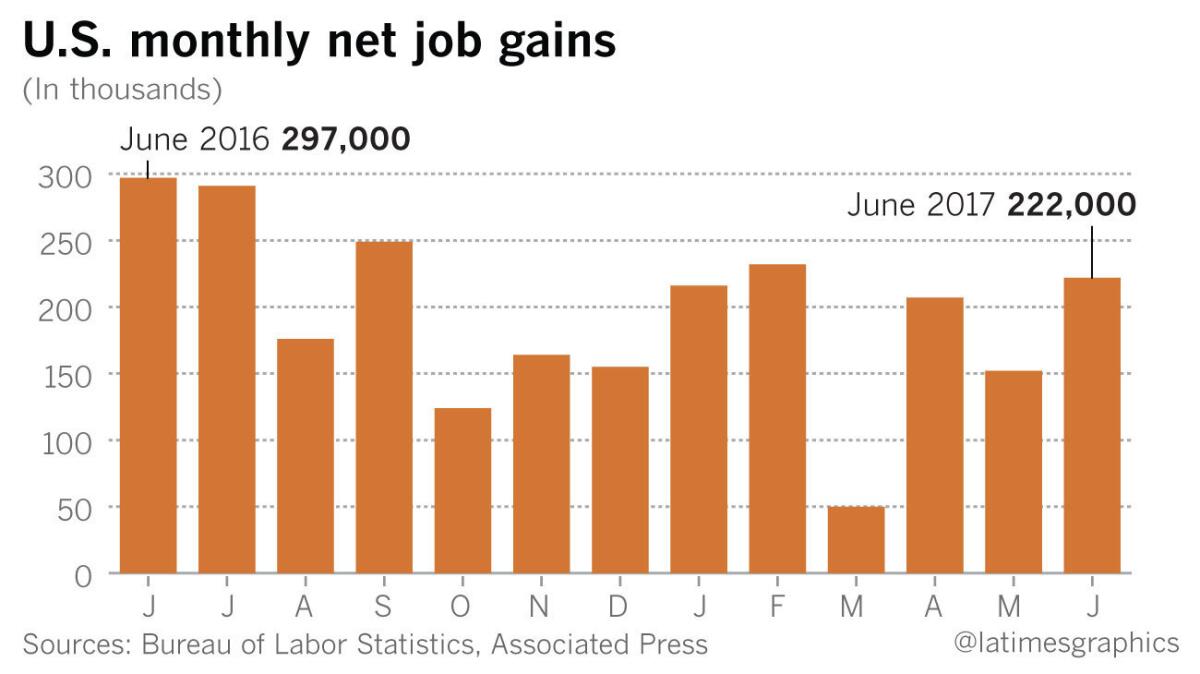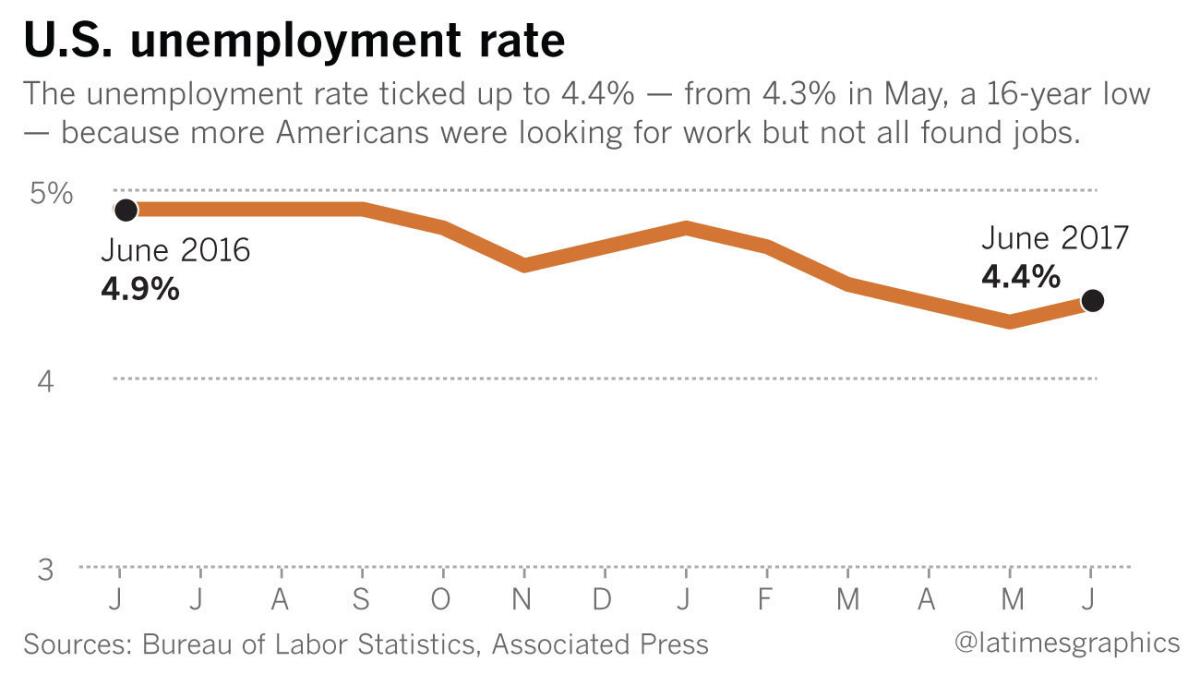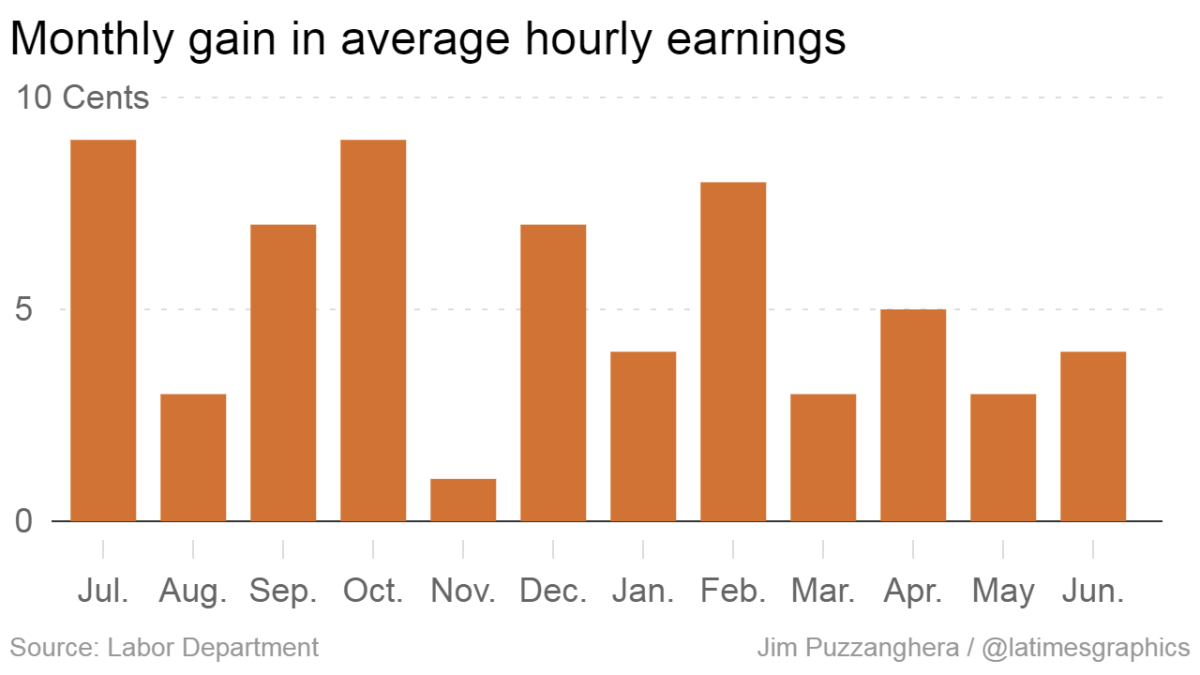Strong June rebound signals job growth is solid again — but substantial raises remain elusive

The new figures suggest businesses may be confident enough to keep hiring despite a slow-growing economy. (Sign up for our free video newsletter here http://bit.ly/2n6VKPR)
- Share via
With a strong rebound in job growth last month, the labor market is back on solid ground. But workers are still struggling to get the substantial wage gains they’ve been craving since the end of the recession, economists said.
Here are the highlights:
- The economy added 222,000 net new jobs, the Labor Department said — the best performance since February and well above analyst expectations.
- The unemployment rate ticked up to 4.4% from May’s 16-year low, but because more people joined the labor force.
- May’s job growth was revised up to 152,000 and April also was revised up, as part of a gain of 47,000 more total jobs for those two months than initially estimated.
- Wages continued their steady but slow recent growth, increasing 4 cents to $26.25.
"Hiring is back to where it has been throughout much of the 8-year-old economic expansion,” said Mark Hamrick, senior economic analyst at financial information website Bankrate.com.
“Growth is modest, not spectacular, which is to be expected for a mature expansion.”
Job growth returns to 2016 pace

With June’s strong growth and the statistical revisions, monthly job gains have averaged 180,000 this year, close to last year’s level of 187,000.
On Monday, President Trump criticized the media for ignoring the “great jobs numbers” since he took office. The White House offered a muted response Friday, with Press Secretary Sean Spicer touting the job gains on Twitter as “great news” for U.S. workers.
Economists said the pace of job growth this year has not been great, but has been solid. And the bounce back in June allays any fears of a significant slowdown.
“This was a good jobs report. It suggests there’s still a fair amount of vitality in the U.S. labor market,” said Nariman Behravesh, chief economist at IHS Markit, a business research and analysis firm.
But the report probably overstated the strength of the market somewhat because it was boosted by a gain of 35,000 net new jobs in state and local government after the sector shed 8,000 positions in May, he said.
The June gains likely represent a temporary jump as school districts made new hires for the fall, Behravesh said. He expected job growth in coming months to be in the range of 150,000 to 180,000.
Retail gains jobs for first time since January

June’s job growth was boosted by large increases in hiring in the healthcare and social-assistance sector, as well as by local governments.
But the most notable move was by retailers. The sector added 8,100 net new jobs in June after shedding 7,200 the previous month.
From February through May, retail payrolls declined by 79,400 jobs as the sector struggled with the growing shift to online shopping.
“The gain in June shows that the industry is still very much meeting the demands of consumers and households,” said Jack Kleinhenz, chief economist for the National Retail Federation.
He cautioned that “one month does not make a trend,” a point echoed by other economists.
“We won’t see sustained employment growth in the retail sector,” said Cathy Barrera, chief economic advisor at ZipRecruiter, the Santa Monica job-hunting site.
“Between the competition with online options for consumers and for new technologies that are replacing workers in stores — self checkout is one example of that — I don’t think those jobs are going to be there in the long run,” she said.
A higher jobless rate is actually good

The unemployment rate rose 0.1 percentage point last month after hitting its lowest level since 2001 in May. But the increase, to 4.4%, was for a good reason — 361,000 people joined the labor force a month after it contracted.
That nudged up the percentage of working-age Americans either working or actively looking for a job to 62.8%. That labor force participation rate still is near a four-decade low, and economists said the increasing retirement of baby boomers makes it difficult to boost the level significantly.
The participation rates for men and women ages 25 to 54 have almost gotten back to their pre-recession levels, Barrera said. But for Americans ages 16 to 24, the recovery has been slower.
“It makes sense that this is the last group to recover,” she said. “There just weren’t a lot of jobs available for young people high school-age or college-age during the recession.”
Some of them have opted to stay in school longer to boost their job qualifications, Barrera said. Getting those Americans back in the workforce will help tighten the labor market and lead to increased wages.
Wage growth is still struggling

Average hourly earnings increased 4 cents last month to $26.25, a slight improvement over May’s gains.
For the 12 months ended June 30, wages have increased 2.5%. That’s a slight increase over the 12-month period ended May 31 and above the low rate of inflation. But it’s still short of the stronger growth economists have been hoping for as the labor market tightens.
“If wages accelerate, that will encourage more people who might have given up looking for work to start looking again,” said Jed Kolko, chief economist with employment website Indeed.com. “That’s why wages are an important and the most troubling piece of the puzzle right now.”
With unemployment low, employers should be forced to increase wages to lure new workers and keep existing ones.
But some of the biggest job gains in June were in lower-wage sectors, like healthcare and temporary workers, which kept wage growth down, Kolko said
“It’s unclear how much the slower wage growth is due to long-term factors, like productivity slowdown and demographic shifts, and how much of it could be reversed by a tighter labor market and employers bidding up wages,” he said.
Still, the job-creation figures for June should provide relief to central bank officials, who have been increasing a key short-term interest rate in large part because of the strength of the labor market.
In June, the Fed nudged the rate up for the third time in six months. Even though the pace of job growth has moderated this year, Fed Chairwoman Janet L. Yellen said the labor market “continues to strengthen.”
If job growth remains solid, the Fed is expected to raise the rate again before the end of the year.
ALSO
Private-sector job growth slows to still-solid 158,000
Workers celebrate L.A.'s new $12 minimum wage, businesses brace for impact
When she interviewed for a dishwashing job, Lina Hu got a $40-million idea
Inside the business of entertainment
The Wide Shot brings you news, analysis and insights on everything from streaming wars to production — and what it all means for the future.
You may occasionally receive promotional content from the Los Angeles Times.








